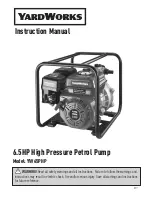
Excessive noise and/or vibration
Item
Description
Action
Check fluid level in reservoir.
Insufficient hydraulic fluid causes cavitation.
Fill the reservoir to proper level.
Check for air in system.
Air in system causes noisy, erratic control.
Purge air and tighten fittings. Check inlet for
leaks.
Check pump inlet pressure/vacuum.
Improper inlet conditions cause erratic behavior
and low output flow.
Correct pump inlet pressure/vacuum conditions.
Refer to the
Hydraulic Parameters
topic.
Inspect shaft couplings.
A loose or incorrect shaft coupling causes
excessive noise and/or vibration.
Repair or replace coupling and ensure that
correct coupling is used.
Check shaft alignment.
Misaligned shafts create excessive noise and/or
vibration.
Correct shaft misalignment.
Hydraulic fluid viscosity above acceptable limits. Hydraulic fluid viscosity above acceptable limits
or low fluid temperature will not allow the pump
to fill or control to operate properly.
Allow system to warm up before operating, or
use fluid with the appropriate viscosity grade for
expected operating temperatures. See
Hydraulic
Fluids and Lubricants Technical Information
Manual
, 520L0463.
Actuator response is sluggish
Item
Description
Action
Check external system relief valve setting.
Low external relief valve setting slows down
system.
Adjust external relief valve setting following
manufacturer’s recommendations. External relief
setting must be above PC setting to operate
properly.
Check PC and LS control setting.
Low PC setting prevents the pump from
achieving full stroke. Low LS setting limits output
flow.
Adjust PC and LS setting. Refer to the
Adjustments
chapter.
Check LS control signal pressures.
Incorrect LS signal will not allow pump to
operate correctly.
Inspect system to ensure that proper LS signal
transmit to pump.
Internal system leaks.
Worn internal parts don’t allow the pump to
operate properly.
Refer to Authorized Service Center for required
repair.
Hydraulic fluid viscosity above acceptable limits. Hydraulic fluid viscosity above acceptable limits
or low fluid temperature will not allow the pump
to fill or control to operate properly.
Allow system to warm up before operation or sue
fluid with the appropriate viscosity grade for
expected operating temperatures. See
Hydraulic
Fluids and Lubricants Technical Information
Manual
, 520L0463.
Check external system valving.
Malfunctioning valving may not allow system to
respond properly.
Repair or replace system valving as required.
Check pump case pressure.
High case pressure causes the system to be
sluggish.
Correct case drain line restrictions.
Check pump inlet pressure/vacuum.
High inlet vacuum causes low output flow.
Correct inlet pressure conditions.
System operating hot
Item
Description
Action
Check fluid level in reservoir.
Insufficient volume of hydraulic fluid will not
meet cooling demands of system.
Fill reservoir to proper level. Verify proper size of
reservoir.
Hydraulic fluid viscosity above acceptable limits. Fluid viscosity above acceptable limits or low
fluid temperature will not allow the pump to fill
or control to operate properly.
Allow system to warm up before operation or use
fluid with the appropriate viscosity grade for
expected operating temperatures. See
Hydraulic
fluids, Series 45 Technical Information Manual ,
520L0519.
Service Manual
Series 45 Frame K2 Open Circuit Axial Piston Pumps
Troubleshooting
20 |
©
Danfoss | April 2017
AX00000301en-US0101
















































